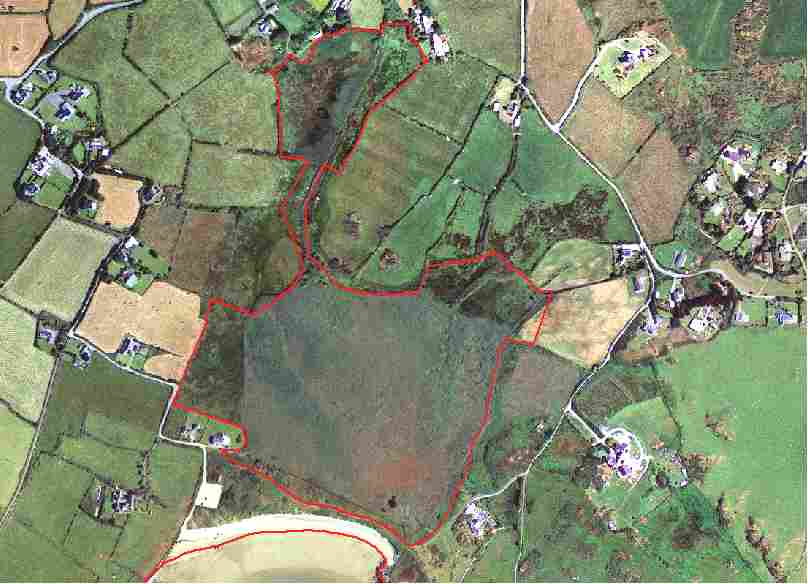
RHOSCOLYN REEDBED
SITE OF SPECIAL SCIENTIFIC INTEREST
MANAGEMENT STATEMENT

Aerial photograph June 2000 (Copyright: Getmapping plc 2005)
What is ‘special’ about Rhoscolyn Reedbed SSSI?
Rhoscolyn Reedbed has one special feature:
tall fen dominated by common reed.
As well as the feature listed above, Rhoscolyn Reedbed has other habitats that contribute to the special interest. These include lesser pond-sedge swamp and great pond sedge dominated swamp along with peripheral areas of scrub and wet meadow. This mixture of habitats is important for much of the wildlife including water rail. grasshopper warbler and reed bunting and in the past, bittern, and these too are key components of the special interest of the site. Unless specified below, management of this site should aim to look after these habitats as well as the listed features of interest.
Common reed should occur extensively throughout this site. Much of it should be in standing water with some open water pools or channels evident and this part would be relatively species poor. Peripheral areas should be more diverse tall fen vegetation dominated by great fen sedge along with wild angelica, ragged robin, purple loosestrife and marsh-bedstraw . Lesser pond sedge swamp should occur in the northwest of the site. The site should contribute towards breeding and feeding bittern habitat in the vicinity and should also support water rail, grasshopper warbler and reed bunting. Scrub should be restricted to no more than 10% of the site area for the foreseeable future.
In the long term, sea level rise and storms may breach the protecting sand and shingle bar and the site could be subject to tidal incursion. In this event development of saltmarsh and freshwater transition marsh may be the only sustainable option.
What management is needed on Rhoscolyn Reedbed SSSI and why?
Although Rhoscolyn Reedbed is an excellent place for wildlife it will only remain so if the necessary management continues. CCW’s aim is to work with you to ensure that this management is carried out.
What does this mean in practice?
There are many factors that could damage the special features at Rhoscolyn Reedbed SSSI if they are not properly managed. These are the ones we regard as most important:
Nutrient levels: The vegetation of this site is dependent on a water supply with only moderate levels of nutrients such as nitrates and phosphates. Increased nutrient levels may lead to increased growth of species such as bulrush which may out-compete more desirable species.
Natural succession: Natural processes will gradually infill the site with silt and peat. Willow scrub will invade and develop carr woodland despite work in recent years to control it. The period of reedbed dominance should be extended by willow removal, controlled burning or raised water level.
Water level and extent: Reedbed and fen vegetation is dependent on a continuing high water table. Any work that reduces inputs to or increases outputs from the site has the potential to damage the site. The culvert and tidal flap through the dune ridge controls the water level of the entire site, draining it on low tides but preventing tidal incursion on high tides. This has resulted in an over-drained site, accentuating the tendency for succession to woodland. However the presence of adjacent residential property precludes raising water level over the whole of the site without extensive protective works (bund and pumped drainage). Options remain for some intervention to restore water levels on parts of the site, either through the construction of low terraces or careful excavation or both. Continuing rise in sea levels could alter this assessment.
Up to 1 ha of open water could be created by excavation of channels (perhaps in association with terraces) in areas of reedbed and the excavation of scrapes in areas of wet meadow. Spoil should be disposed of off-site or on areas of higher ground. Details must be consented by CCW.
Burning: Controlled burning of reed is used to “clean” commercial reedbeds. Although extensive or frequent fire has the potential to decimate invertebrate populations of importance to bird life, occasional controlled burns of part of the site in late winter will reduce litter build-up and scorch invasive willow scrub.
Grazing (winter)
Winter grazing does not affect common reed, but can assist the control of scrub and the creation of open ground (and bird foraging areas) through light poaching.
Finally
Our knowledge of wildlife is continually improving. It is possible that new features of value may appear and new management issues may arise in the future, whilst other issues may disappear. This statement is written with the best information we have now, but may have to change in the future as our understanding improves. Any information you can provide on the wildlife of your site, its management and its conservation would be much appreciated.
If you would like to discuss any aspect of your SSSI, or have any concerns about your SSSI, please contact your local CCW office.
Your local office is;
Cyngor Cefn Gwlad Cymru/Countryside Council for Wales
North Region
Llys y Bont,
Ffordd y Parc,
Parc Menai,
Bangor,
Gwynedd, LL57 4BN,
Fax: 01248 679259